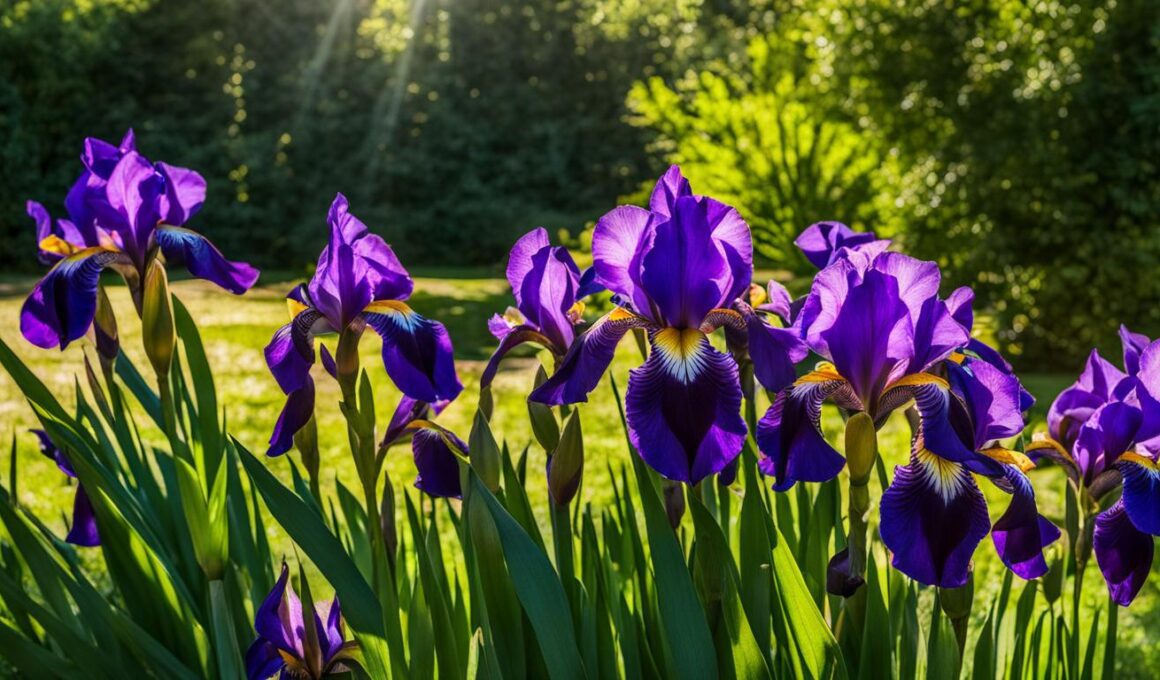Are you wondering about the sunlight requirements for irises? If so, you’re in the right place. Irises are stunning flowers that can add a vibrant splash of color to any garden. But do they need full sun to thrive?
The answer is yes, irises do prefer full sun. While they can tolerate partial shade, they bloom best when exposed to ample sunlight. This is especially true for Dutch irises, which are known for their striking appearance and easy growth.
When planted in a sunny spot with hot and dry soil during the summer months, irises can even naturalize and multiply, creating a breathtaking display. They are one of the first spring bulbs to blossom, making the most of early spring sunshine.
It’s important to note that the suitability of planting irises in perennial borders depends on the climate of your region. In cooler and wetter areas, it’s best to treat irises as annuals and plant fresh bulbs in the fall. Additionally, the quality and size of the bulbs can impact the quality of the blooms, so consider investing in top-quality Dutch iris bulbs for a vibrant and stunning spring display.
In the following sections, we will dive deeper into caring for irises, including tips on watering, planting, and more. So keep reading to learn all you need to know about growing these beautiful flowers in your garden.
Iris Care Tips
When caring for irises, it’s important to provide the right conditions for them to thrive. Follow these care tips to ensure your irises flourish in your garden.
1. Soil and Moisture: Irises require well-draining soil and prefer moist but not soggy conditions. They can tolerate drought but thrive with consistent moisture. Aim to water them when the top inch of soil is dry to avoid overwatering and root rot.
2. Sunlight Requirements: Irises need full, bright sun for at least six to eight hours per day. Adequate sunlight ensures proper blooming and prevents the stalks from growing tall and grassy.
3. Fertilizer: In nutrient-rich soil, fertilizing irises is not necessary. However, if your soil quality is poor, consider applying a balanced fertilizer to provide essential nutrients for optimal growth.
Remember: Caring for irises involves providing them with well-draining soil, regular watering, and ample sunlight. By creating the ideal environment, you can enjoy the stunning blooms of irises in your garden year after year.
When and How to Plant Irises
Planting irises at the right time and in the right way is crucial for their successful growth and bloom. Follow these guidelines to ensure your irises thrive in your garden:
- Timing: The best time to plant irises is in late summer or early fall, typically from late July through early September. This timing allows the plants enough time to establish themselves before the first frost.
- Rhizomes: Irises are usually purchased as rhizomes, which are small stalk-like sprouts attached to a partially developed root system. When planting irises, avoid burying the rhizomes too deep in the soil. Leave a small portion of the rhizome visible above the soil’s surface.
- Spacing: The spacing between iris plants should be around six to twelve inches to allow for their lanky growth. Give them enough room to spread out and flourish.
How to Plant Irises:
Follow these steps to plant your irises:
- Choose a sunny location in your garden where the irises will receive at least six to eight hours of direct sunlight each day.
- Prepare the soil by removing any weeds, rocks, or debris. Loosen the soil and amend it with organic matter if necessary.
- Dig a hole approximately twice the width and depth of the rhizome.
- Place the rhizome in the hole, making sure that the top of the rhizome is just above the soil’s surface.
- Fill the hole with soil, gently firming it around the rhizome to eliminate air pockets.
- Water the newly planted irises thoroughly to settle the soil.
- Apply a layer of mulch around the plants to help conserve moisture and suppress weeds.
By following these steps, you can ensure that your irises have a strong start and will reward you with beautiful blooms in the coming seasons. Happy gardening!
Will Transplanting My Irises Affect Their Sunlight Needs?
When considering whether to transplant irises successfully, tips regarding their sunlight needs should be taken into account. Irises thrive in full sun, requiring at least six hours of direct sunlight daily. Therefore, when transplanting irises, ensure they are placed in a location that still meets their sunlight requirements to ensure their healthy growth and blooming.
Conclusion
Summarizing the sunlight requirements of irises, it is evident that these sun-loving perennials thrive best in full sun. In order to ensure healthy growth and vibrant blooms, it is essential to provide irises with at least six to eight hours of bright sunlight daily. While they can tolerate partial shade, the optimal condition for irises is to bask in the full glory of the sun.
To keep your irises happy and flourishing, it is equally important to meet their other basic needs. Ensure you plant irises in well-draining soil and avoid overwatering, as they prefer moist but not soggy conditions. Additionally, pay attention to the timing of planting, as late summer or early fall provides ample time for the plants to establish before winter sets in.
By following these simple guidelines, you can enjoy the stunning beauty and elegance that irises bring to your garden year after year. So go ahead and create a sunny haven for these magnificent flowers, and watch as they brighten up your outdoor space with their colorful blooms.









